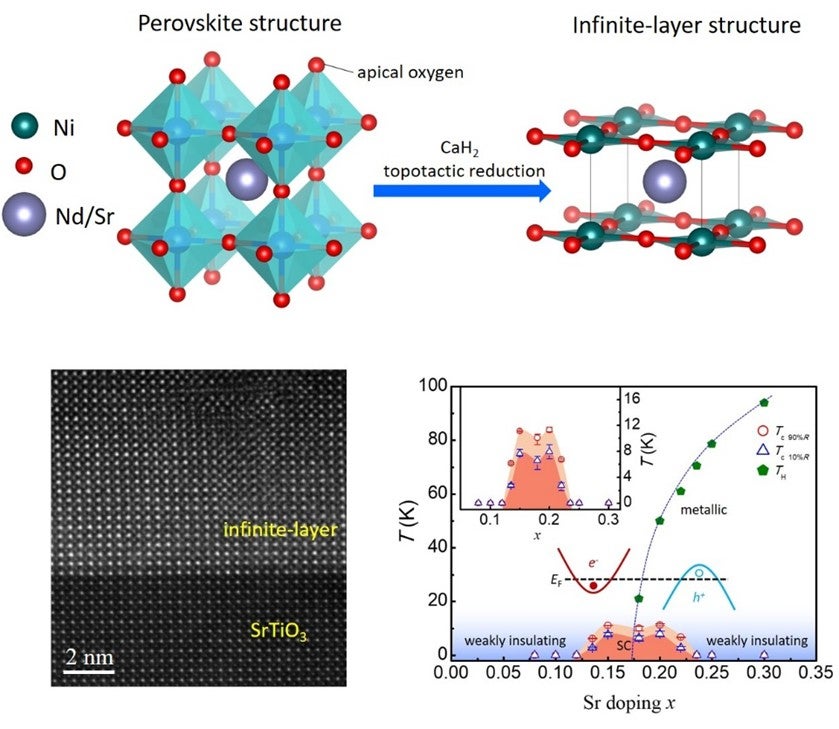Phase diagram for infinite layer nickel superconductors
Ariando (Group Leader, Physics) January 18, 2021NUS physicists have developed a method to induce the transition of a rare-earth nickelate from their native perovskite form to infinite-layer structures. This allowed them to build a complete phase diagram of this nickelate superconductor.
A superconductor is a material system that can conduct electrical current with zero resistance when it becomes colder than a “critical temperature”, known as the superconducting transition temperature Tc. Conventional superconductors usually have a Tc lower than the limit of around 30 K (268 degrees below room temperature) predicted based on the Bardeen–Cooper–Schrieffer (BCS) theory. This limits the use of superconducting devices in our daily lives. For decades, researchers have been trying to push this Tc higher by synthesising new materials. It is also important to understand the physical mechanism. The so-called high temperature superconductivity in compounds containing copper oxide layers (known as the cuprates), with Tc above the BCS limit and subsequently above the boiling point of liquid nitrogen (77 K), was discovered in late ’80s. Since then the Tc has been stagnant and although important research outcomes have been made, the origin and mechanism of the high-Tc superconductivity is still a mystery. A new superconducting family with a similar crystal and electronic structure as the cuprate is one of the paths in the search for potentially higher Tc materials and to understand the underlying mechanism of high-Tc superconductivity.
Recently, researchers have discovered the presence of superconductivity in rare-earth nickelate compounds, an analog of the cuprate. Studying this cuprate analog could potentially lead to a better understanding of high temperature superconductivity, and the possibility to predict, design and synthesise higher Tc superconductors. However, it became apparent that nickelate superconductors are more challenging to produce than initially thought. Nine months after this discovery, a research team led by Prof ARIANDO from the Department of Physics, NUS, became the first group to reproduce this result. More importantly, they successfully developed the phase diagram of the nickelate superconductor.
To achieve this, Prof ARIANDO’s group developed a topotactic reduction technique to transform thin films of rare-earth nickelate (NdNiO2) from its usual perovskite crystalline form to a new doped structural form, known as infinite-layer structures. In this material, superconductivity arises when the nickelate compound is doped with strontium (Sr) impurities and it exists in its infinite-layer structural form. The technique allowed the research team to study the superconductivity as a function of doping. They constructed the phase diagram for this material system, and found the presence of a superconducting dome region (doping dependent Tc) and weakly insulating regime by the side of the dome (See Figure).
In their experiments, the researchers used a pulsed laser deposition technique to synthesise Sr-doped nickelate Nd1-xSrxNiO3 thin films on strontium titanate (SrTiO3) substrates. The as-grown thin film, together with a reagent, calcium hydride (CaH2), was put into a vacuum chamber to induce a reduction reaction. During the reduction process, the apical oxygen atom in the NiO6 octahedra is removed. This causes the perovskite Nd1-xSrxNiO3 to transform into the infinite-layer Nd1-xSrxNiO2. The researchers applied different levels of Sr doping concentrations and found that superconductivity appears in the infinite-layer Nd1-xSrxNiO2 when the Sr composition is between x = 0.135 and 0.235. This forms a superconducting dome-shaped region. More interestingly, they found that besides the superconducting region, weakly insulating behaviour can be observed at low temperatures. This unique behaviour is different from other high-Tc material systems such as cuprates.
Prof Ariando said, “By introducing suitable impurities to the insulating parent compound, the nickelate material system can exhibit high-Tc superconductivity. Our findings can provide further insights to better understand the doping-dependent properties in these material systems and to search for other superconducting materials in the “nickel family””.

(Top) Figure shows the transformation of the perovskite structure Nd1-xSrxNiO3 to the infinite-layer structure Nd1-xSrxNiO2 using calcium hydride (CaH2). (Bottom) Figure shows the high-angle annular dark-field scanning transmission electron microscopy (HAADF-STEM) image and the phase diagram of infinite-layer Nd1-xSrxNiO2 films on single crystalline SrTiO3 substrate. The Tc90%R and Tc10%R are defined to be the temperature at which the resistivity drops to 90% and 10% of the value at 15 K (the onset of the superconductivity) respectively. The inset in the left upper corner of the plot is the enlarged view of the superconducting dome region. TH shows the temperature at which the majority of charge carriers changes from electrons to holes. [Credit: Physical Review Letters]
Reference
Zeng SW; Tang CS; Yin X; Li CJ; Huang Z; Hu JX; Liu W; Omar GJ; Jani H; Lim ZS; Han K; Wan DY; Yang P; Wee ATS; Ariando A*, “Phase diagram and superconducting dome of infinite-layer Nd1−xSrxNiO2 thin films” PHYSICAL REVIEW LETTERS Volume: 125 Page: 147003 DOI: 10.1103/PhysRevLett.125.147003 Published 2020.


